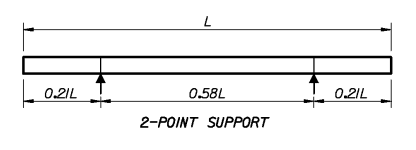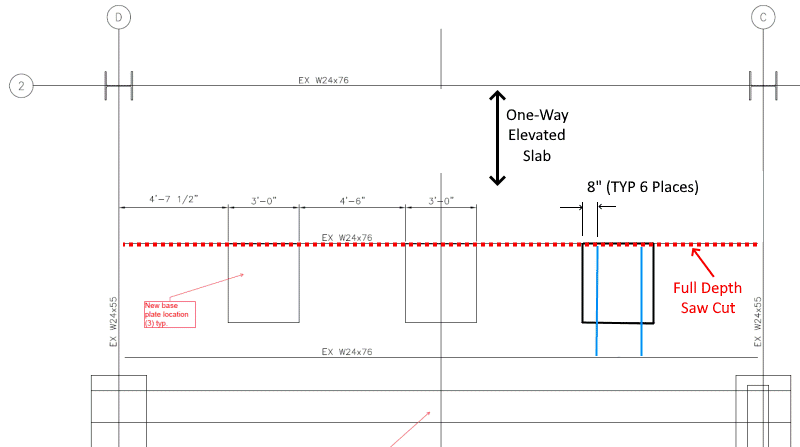Hello All,
I have a situation with an existing elevated one-way slab that is requiring the top portion of the slab be chipped out. It is an existing 7" slab that additionally includes the thickness of the top flanges of the steel beams below. It has existing reinforcing at top and bottom in both directions. I have been asked to evaluate the slab in order to cut 3" into the top of the slab so they can install equipment base plates with grout. There will be multiple base plates in a row along the existing steel beam length, but 4' between the plates where the slab would remain in tact. The problem is that I will have to start the cut on the center line of the steel beam below and go to a little past the middle of the span. While the bottom reinforcing could remain in tact, the top reinforcing will be completely demoed with the concrete. I plan to add new steel below spanning in the direction of the one-way slab to help support the newly cut slab. This new steel would be on both sides of the existing steel beam below.
My questions are:
1. Should I saw cut the slab down to the top of the existing steel beam to break the continuous slab and force it into a simply supported situation or will cutting the top rebar do that on its own?
3. The top flanges of the existing steel beams are embedded in the concrete slab essentially binding them together. Would I need to bolt the new steel beams into the bottom of the existing concrete slab or just create full bearing with solid packed grout?
4. Is there anything else I need to be considering in this situation?
Thank you in advance for any help.
I have a situation with an existing elevated one-way slab that is requiring the top portion of the slab be chipped out. It is an existing 7" slab that additionally includes the thickness of the top flanges of the steel beams below. It has existing reinforcing at top and bottom in both directions. I have been asked to evaluate the slab in order to cut 3" into the top of the slab so they can install equipment base plates with grout. There will be multiple base plates in a row along the existing steel beam length, but 4' between the plates where the slab would remain in tact. The problem is that I will have to start the cut on the center line of the steel beam below and go to a little past the middle of the span. While the bottom reinforcing could remain in tact, the top reinforcing will be completely demoed with the concrete. I plan to add new steel below spanning in the direction of the one-way slab to help support the newly cut slab. This new steel would be on both sides of the existing steel beam below.
My questions are:
1. Should I saw cut the slab down to the top of the existing steel beam to break the continuous slab and force it into a simply supported situation or will cutting the top rebar do that on its own?
I'm trying to eliminate the negative moment above the steel beam as I'm struggling to find a good way to reinforce the slab from below in a way to account for it. Obviously, by cutting the top rebar the negative moment will not be able to transfer to the other side but will it 'go away' or cause issues if I don't cut the bottom bars? Also, one of the problems with cutting the bottom rebar is that it will create a situation where water could get into that crack and start corrosion. Though this might be mitigated by the presence of the new grout if it never cracks.
2. The base plates are 3' wide (in the direction of the existing steel beam below) so I will be cutting at least 7 tension bars. Load and deflection wise, one new steel beam in the center of the plates will be sufficient, but my plan was to add one new beam on each side of the plate (i.e. 3' apart). For cracking and movement, would it be a good idea to add one beam in the center of the plates as well or is that overkill?3. The top flanges of the existing steel beams are embedded in the concrete slab essentially binding them together. Would I need to bolt the new steel beams into the bottom of the existing concrete slab or just create full bearing with solid packed grout?
4. Is there anything else I need to be considering in this situation?
Thank you in advance for any help.


